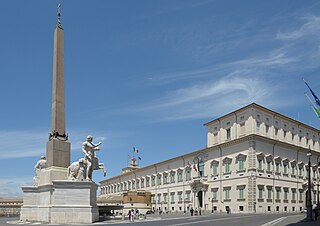
The Quirinal Palace is a historic building in Rome, Italy, one of the three current official residences of the President of the Italian Republic, together with Villa Rosebery in Naples and the Tenuta di Castelporziano, an estate on the outskirts of Rome, some 25 km from the centre of the city. It is located on the Quirinal Hill, the highest of the seven hills of Rome in an area colloquially called Monte Cavallo. It has served as the residence for thirty Popes, four Kings of Italy and twelve Presidents of the Italian Republic.

Palazzo Farnese or Farnese Palace is one of the most important High Renaissance palaces in Rome. Owned by the Italian Republic, it was given to the French government in 1936 for a period of 99 years, and currently serves as the French embassy in Italy.

Palazzo Pamphilj, also spelled Palazzo Pamphili, is a palace facing onto the Piazza Navona in Rome, Italy. It was built between 1644 and 1650.
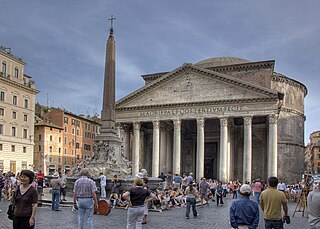
Pigna[ˈpiɲɲa] is the 9th rione of Rome, identified by the initials R. IX, and belongs to the Municipio I. The name means "pine cone" in Italian, and the symbol of the rione is the colossal bronze pine cone, that stand above the Pigna. The fountain, that was initially located in the Baths of Agrippa, now decorates a vast niche in the wall of the Vatican facing the Cortile della Pigna, located in Vatican City.

Castro Pretorio is the 18th rione of Rome (Italy), identified by the initials R. XVIII, and it is located within the Municipio I. The rione takes its name by the ruins of the Castrum Praetorium, the barracks of the Praetorian Guard, included in the Aurelian Walls.
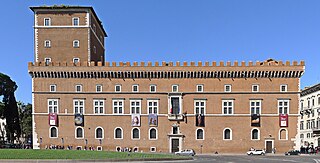
The Palazzo Venezia, formerly Palace of St. Mark, is a palazzo (palace) in central Rome, Italy, just north of the Capitoline Hill. The original structure of this great architectural complex consisted of a modest medieval house intended as the residence of the cardinals appointed to the church of San Marco. In 1469 it became a residential papal palace, having undergone a massive extension, and in 1564, Pope Pius IV, to win the sympathies of the Republic of Venice, gave the mansion to the Venetian embassy to Rome on the terms that part of the building would be kept as a residence for the cardinals, the Apartment Cibo, and that the republic would provide for the building's maintenance and future restoration. The palace faces Piazza Venezia and Via del Plebiscito. It currently houses the National Museum of the Palazzo Venezia.

The Palazzo Massimo alle Colonne is a Renaissance palace in Rome, Italy. The palace was designed by Baldassarre Peruzzi in 1532–1536 on a site of three contiguous palaces owned by the old Roman Massimo family and built after arson destroyed the earlier structures during the Sack of Rome (1527). In addition the curved facade was dictated by foundations built upon the stands for the stadium (odeon) of the emperor Domitian. It fronts the now-busy Corso Vittorio Emanuele II, a few hundred yards from the front of the church of Sant'Andrea della Valle.

The Via Giulia is a street of historical and architectural importance in Rome, Italy, which runs along the left (east) bank of the Tiber from Piazza San Vincenzo Pallotti, near Ponte Sisto, to Piazza dell'Oro. It is about 1 kilometre long and connects the Regola and Ponte Rioni.

Palazzo Borghese is a palace in Rome, Italy, the main seat of the Borghese family. It was nicknamed il Cembalo due to its unusual trapezoidal groundplan; its narrowest facade faces the River Tiber. The entrance at the opposite end of the building, the "keyboard" of the cembalo, faces onto the Fontanella di Borghese, with another in a great flanking facade to the Piazza Borghese that is extended by a slightly angled facade leading down Via Borghese towards the river. Both these entrances lead into a large courtyard on one side of which is a two level open arcade, with paired Doric and Ionic columns, that frames the garden beyond.

The Chigi Palace is a palace and former noble residence in Rome which is the seat of the Council of Ministers and the official residence of the Prime Minister of Italy. Since 13 February 2021, the tenant of the Chigi Palace has been Prime Minister Mario Draghi. It is located in the Piazza Colonna, next to Palazzo Montecitorio, seat of the Chamber of Deputies.
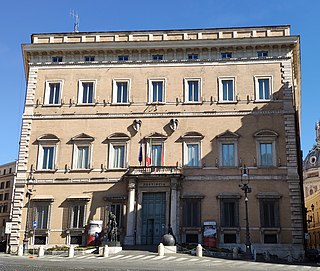
Palazzo Valentini is a palazzo in central Rome, Italy, not far from Piazza Venezia. Since 1873 it has been the base of the provincial and prefectural administration of Rome.
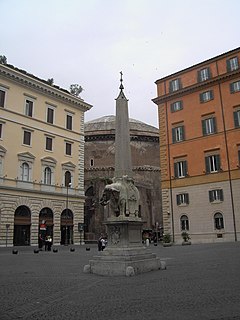
Piazza della Minerva is a piazza in Rome, Italy, near the Pantheon. Its name derives from the existence of a temple built on the site by Pompey dedicated to Minerva Calcidica, whose statue is now in the Vatican Museums.

The Palace of Justice, Rome, the seat of the Supreme Court of Cassation and the Judicial Public Library, is located in the Prati district of Rome. It fronts onto the Piazza dei Tribunali, the Via Triboniano, the Piazza Cavour, and the Via Ulpiano. The huge building is popularly called in Italian the Palazzaccio .

Piazza d'Aracoeli is a square of Rome (Italy), placed at the base of the Capitoline Hill, in the Rione X Campitelli.

The Teatro Capranica is a theatre situated at 101 Piazza Capranica in the Colonna district of Rome. Originally constructed in 1679 by the Capranica family and housed in the early Renaissance Palazzo Capranica, it was the second public theatre to open in Rome. It was the site of many premieres of Baroque operas including Caldara's Tito e Berenice, Scarlatti's Griselda, and Vivaldi's Ercole su'l Termodonte. The Capranica ceased operating as a full-scale theatre and opera house in 1881 and in 1922 was converted into a cinema. Following the closure of the cinema in 2000, it has functioned on a hire basis as a conference and performance venue.

Via dei Coronari is a street in the historic center of Rome. The road, flanked by buildings mostly erected in the 15th and the 16th century, belongs entirely to the rione Ponte and is one of the most picturesque roads of the old city, having maintained the character of an Italian Renaissance street.

Palazzo Cesi-Armellini, sometimes known plainly as Palazzo Cesi, is a late Renaissance building in Rome, important for historical and architectural reasons. The palace, which should not be confused with Palazzo Cesi-Gaddi, Palazzo Muti-Cesi, or the destroyed Palazzo Cesi, placed also in Borgo near the southern Colonnade of St. Peter's square, is one of the few Renaissance buildings of the rione Borgo to have survived the destruction of the central part of the neighborhood due to the 20th century construction of Via della Conciliazione, the avenue leading to St. Peter's Basilica. Today, it is owned by the Society of the Divine Savior and part of it is used as their motherhouse.

Palazzo Alicorni is a reconstructed Renaissance building in Rome, important for historical and architectural reasons. The palace, originally lying only a few meters away from Bernini's Colonnades in St. Peter's square, was demolished in 1930 in the wake of the process of the border definition of the newly established Vatican City state, and rebuilt some hundred meters to the east. According to the stylistic analysis, his designer had been identified as Giovanni Mangone, a Lombard architect active in Rome during the 16th century.
Vincenzo Monaco was an Italian architect who collaborated with Amedeo Luccichenti from 1933 to 1963. During this period, Monaco designed more than 450 projects, of which approximately 100 were built. His work can be seen in buildings in Rome, Pisa, Naples, and Taranto, as well as in Dalmatia, Iran, France, and Tunisia.

Palazzo Giustiniani or the Piccolo Colle is a palace on the Via della Dogana Vecchia and Piazza della Rotonda, in Sant'Eustachio, Rome.




















